
Cahokia Jazz by Francis Spufford : the Endless Bookshelf book of the year – 2024

simply messing about in books

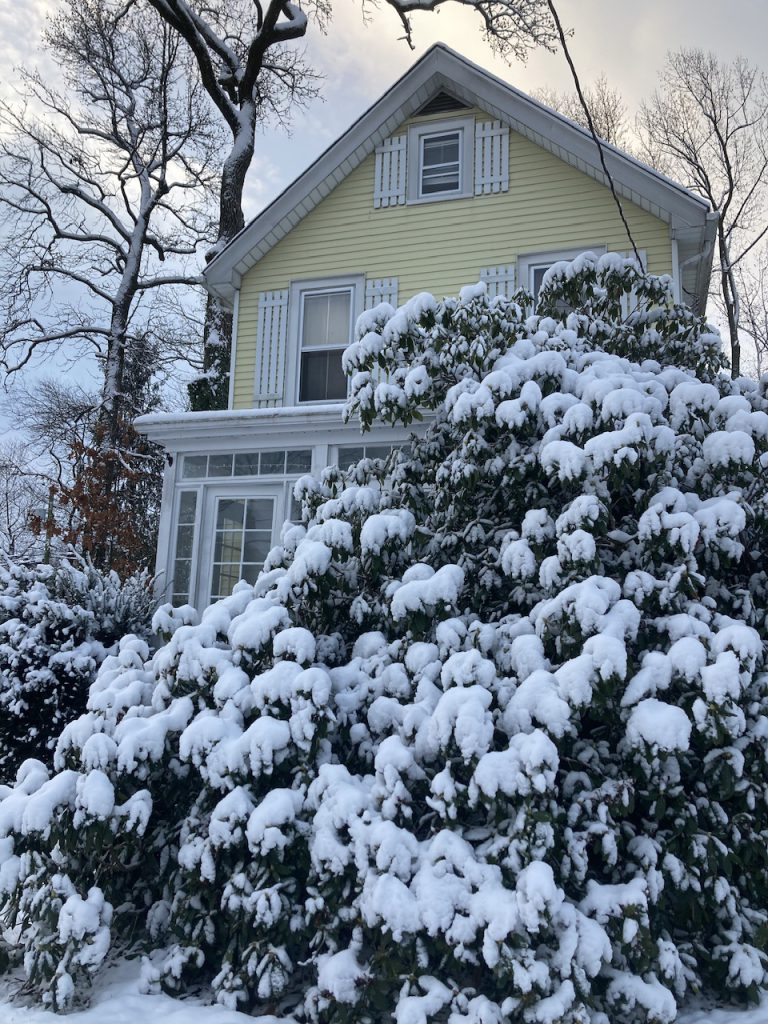
the snow-rhododendrons of Montclair-Himalaya, 21 December
— — —

good morning from the swamps :
view from the glaucous window of a becalmed train, 2 December
/ file under : extreme commute
Readers of the ’shelf and friends in the New York area are invited to an event and presentation, this year honoring PEDRO PONCE, the winner of the Second Tom La Farge Award for Innovative Writing, Teaching and Publishing
It will be held on Friday 11 October 2024, from 6:30 p.m. to 8:30 p.m., at the Ground Floor Gallery of the Grolier Club, 47 East 60th St..(between Madison and Park aves.), NYC, NY 10022.
Pedro will be interviewed, discuss the writing of Tom La Farge, and read from his own work.
This annual award in the amount of $10,000 is designed to encourage and foster literary activity that combines serious play, imagination, erudition and innovative practice. To learn more about the Tom La Farge Award :
https://www.thetomlafargeaward.com/
Refreshments will be served and the doors open at 6:30 pm.
The event is free and open to the public but seating is limited so please RSVP to : Wendy Walker, wwalker377@gmail.com
We look forward to sharing an evening of wonderful writing with you!
Wendy Walker
& the Tom La Farge Committee :
Corina Bardoff
Daniel Levin Becker
Sam Goodman
Michael Kowalski
Eliza Martin
Philip Ording
posted on behalf of the Committee by
Henry Wessells
Zagava Books will be publishing Another Green World, a collection of short fiction expanded from the 2003 work with the same title and adding two previously uncollected stories. The book will be available in two states, a narrow format paperback and a numbered hardcover. Another Green World is in production for late spring 2025 and can be pre-ordered here :
https://zagava.de/shop/another-green-world
The table of contents includes the following stories :
Of the first edition, Guy Davenport wrote,
“If you don’t believe in magic, read Henry Wessells and find out how wrong you are.”
Mark Valentine writes : “Henry Wessells delights in books and mysteries and writes with a zest for the arcane and a talent for the oblique and surprising.”
Zagava produce beautiful books and I am delighted to join the ranks of their authors.

afternoon sun in Amsterdam, Leidseplein
— — —
The Endless Bookshelf will be filing despatches from Amsterdam and environs during the week of the A.I.B congress (words and images dropped in here as found).
— — —
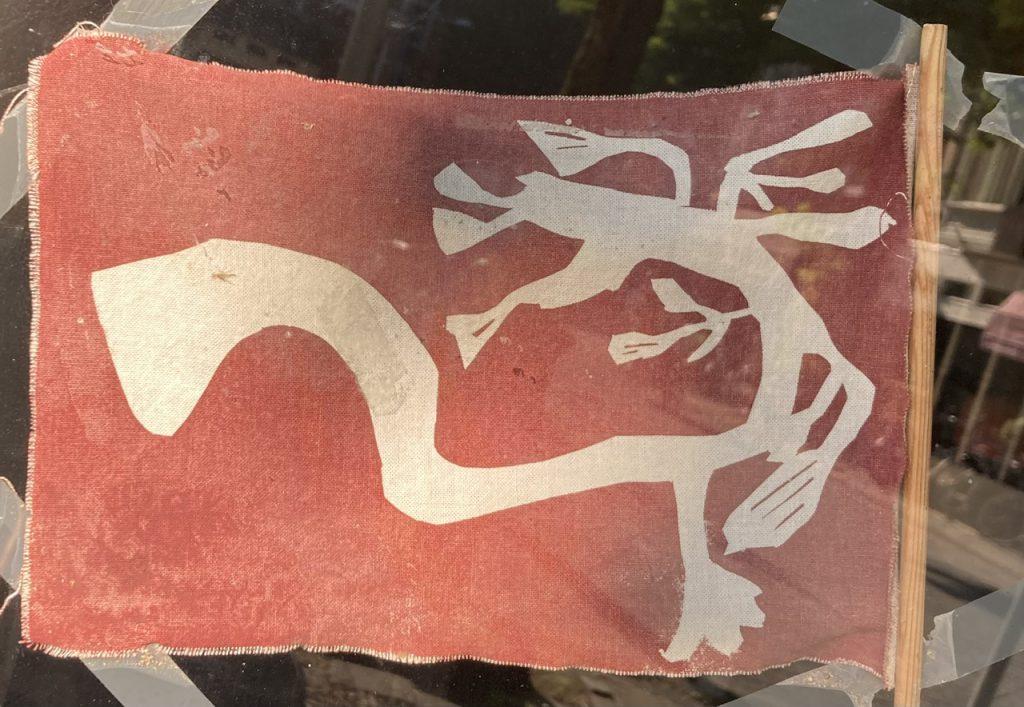
things are symbols of themselves / semiotics of Amsterdam
— — —
vegan potato truffle cappuccino
[surprise innovation offered during the medley of the Daalder experience, vegan mode]
— — —

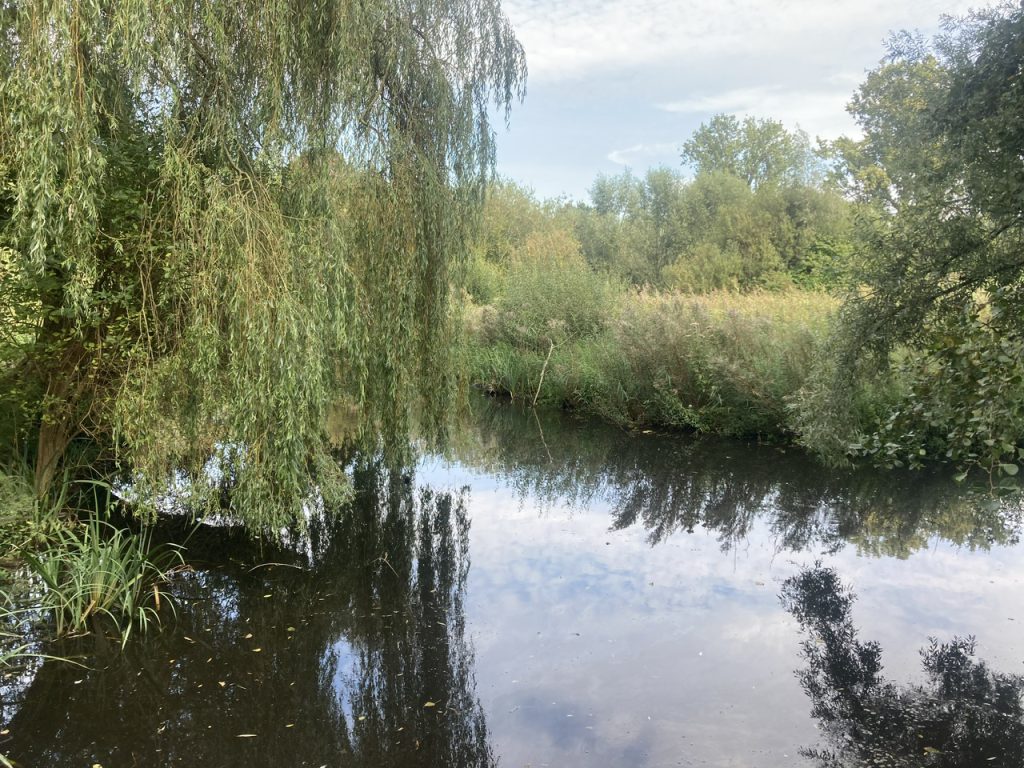
Vondelpark
— — —

Watcher at the edge of the cow pasture, in the Amsterdamse Bos.
— — —

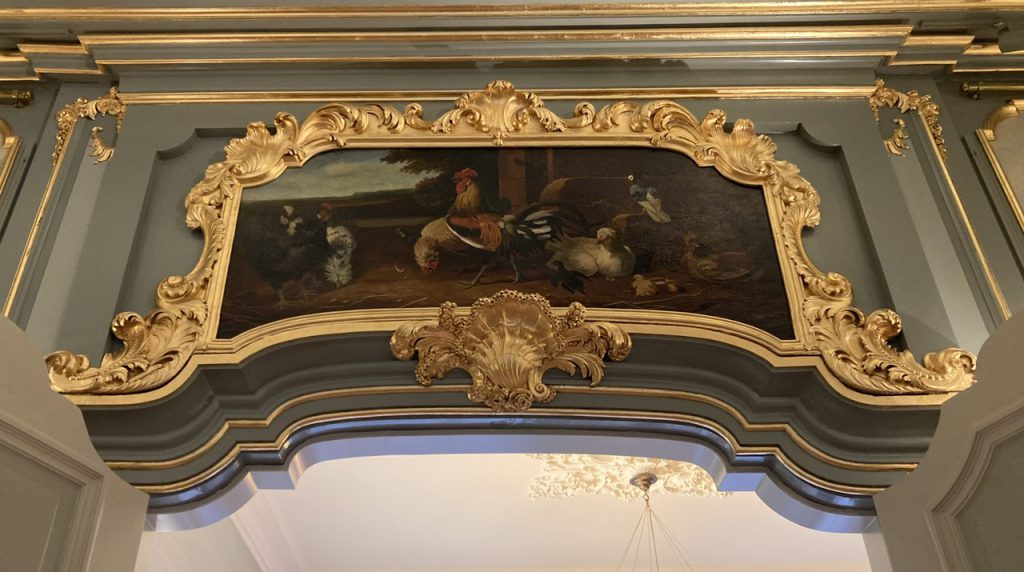

Herengracht
— — —
‘Gallia est omnis divisa in partes tres’
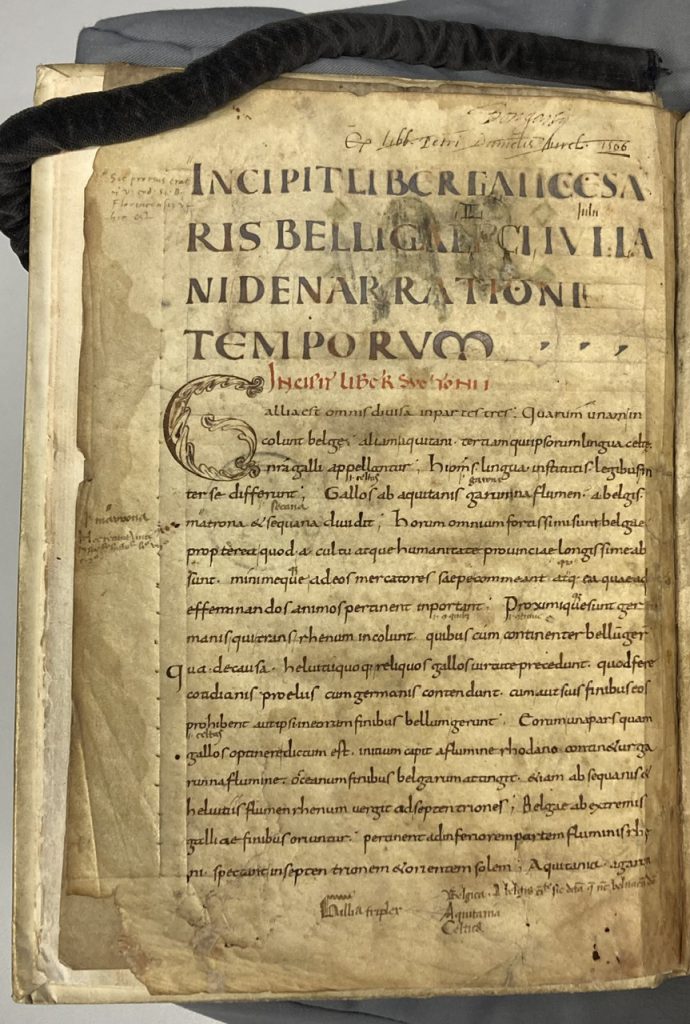
The earliest surviving manuscript of Caesar’s De bello gallico (On the Gallic War), ca. ninth century CE, at the Allard Pierson collection, University of Amsterdam.
At the other end of the table, a stack of more than 80 ‘feuilles volantes’ (1916-28) of Kaváfis (Cavafy), scattered leaves of his self-published Poems.

— — —

Breestraat, Leiden
— — —

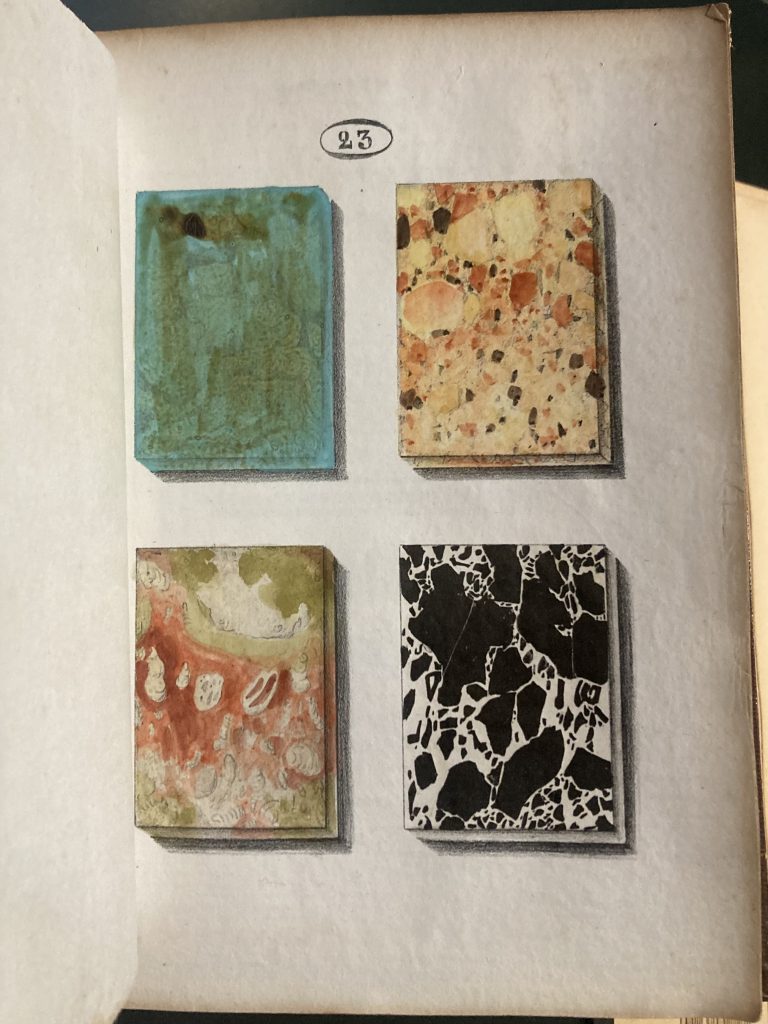
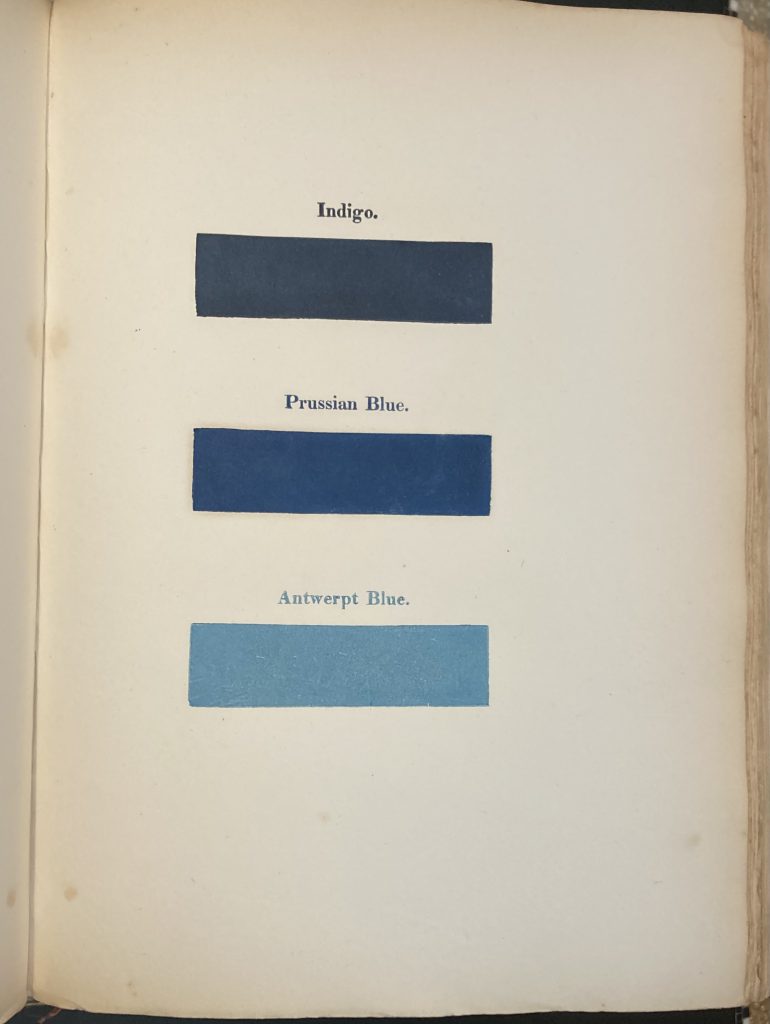

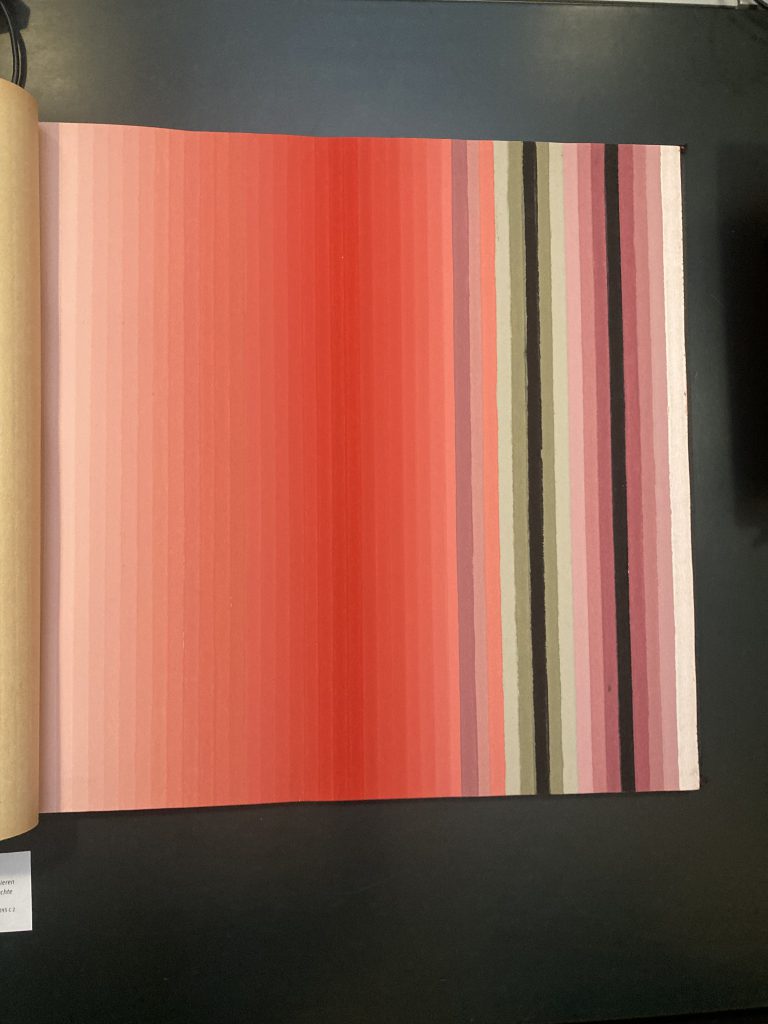
color in the Rijksmuseum library
— — —


— H. N. Werkman. Hot Printing. [Groningen, ca. 1936]. One of three known copies of a portfolio of prints and poems.
At the Koninglijke Bibliotheek = KB, nationale bibliotheek :
Onze wereld is gebouwd met woorden en gevormd door mensen
— — —

— Vincent van Gogh. Trois romans.
— — —

At the Ritman Library, Keizersgracht 123, Amsterdam.
— — —
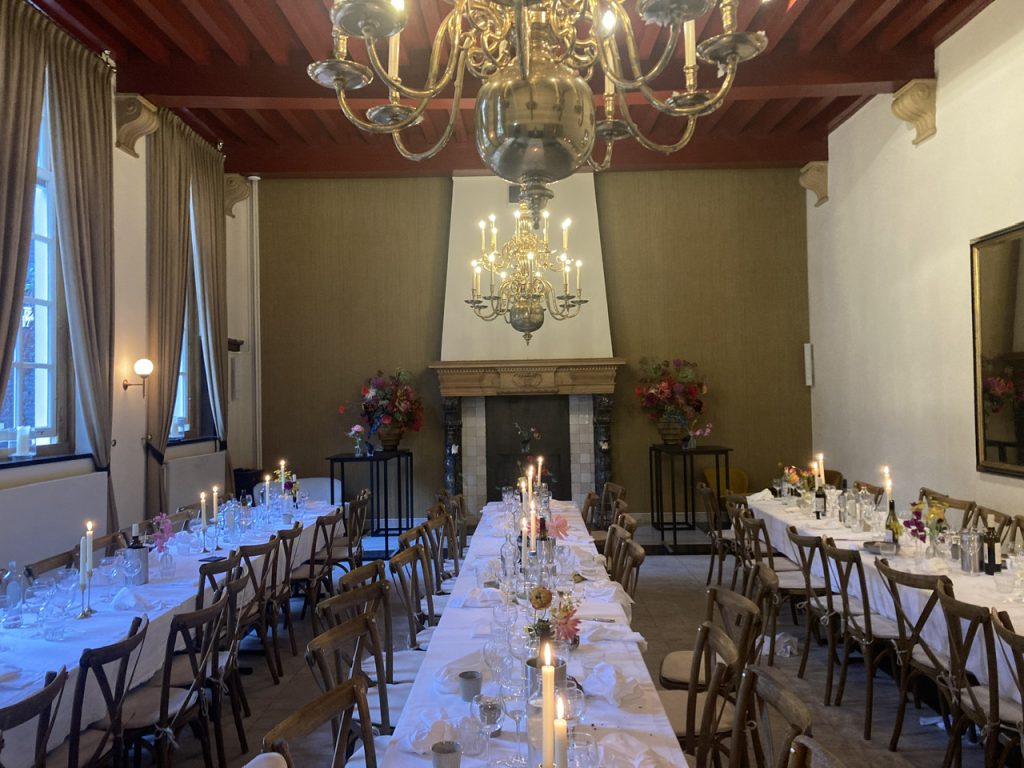
Compagnieszaal, West-Indisch Huis, Amsterdam (this is the room where New Amsterdam was planned)
— — —

rainbow at Schiphol
— — —
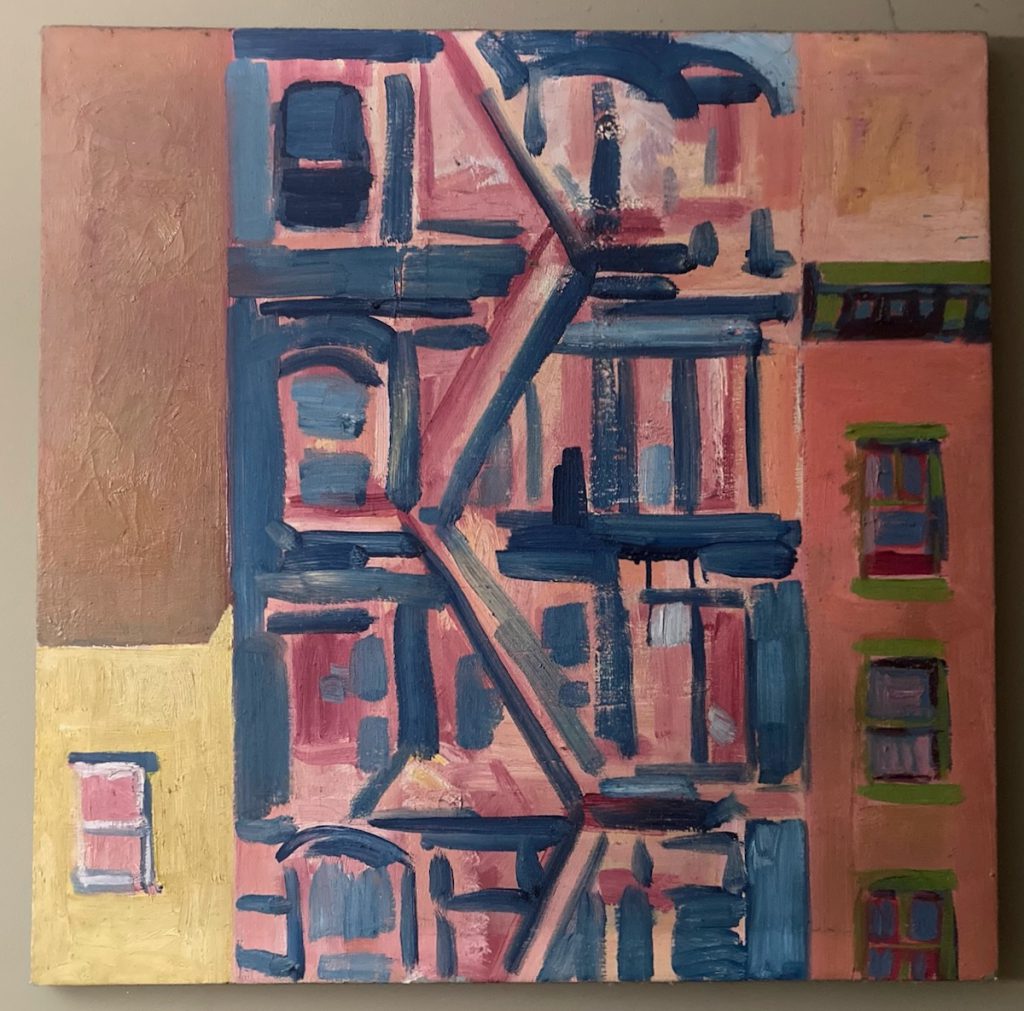
Tony Saunders
21 September 1961 – 11 July 2024
My friend Tony Saunders, artist, musician, and social worker, died in New York City earlier this summer. I wrote a note to be read at private memorial gathering :
Tony was my friend from the moment we met in sophomore year, to the tunes of Brian Eno’s Another green world and the Velvet Underground. If we had some similar high school background stuff, he was very much the City Mouse to my Country Mouse. He encouraged me to question myself, and Princeton, about how I was seeking to educate myself. This (and the music) were early, spontaneous gifts to me. If our paths crossed and diverged and crossed again, our friendship was constant, and regularly renewing. He was a brave person who looked at himself and chose sobriety, and his life was enriched by that choice. He kept making his art, in a variety of media, and on his terms, not following some temporary fashion. And he found a way to integrate his art into a later career as a social worker. He was very articulate about the playful presence of his approach. Not long after Tony died, MJ and I saw the Eno documentary, and both of us said, how much T would have appreciated that; but in truth he had already lived many of Eno’s insights into art and process. He was a great friend and we are lucky to know him and to remember him.
In 2016 Tony recorded a statement for his friend Michael Schickele that is worth looking for : https://matthewschickele.bandcamp.com/track/tony
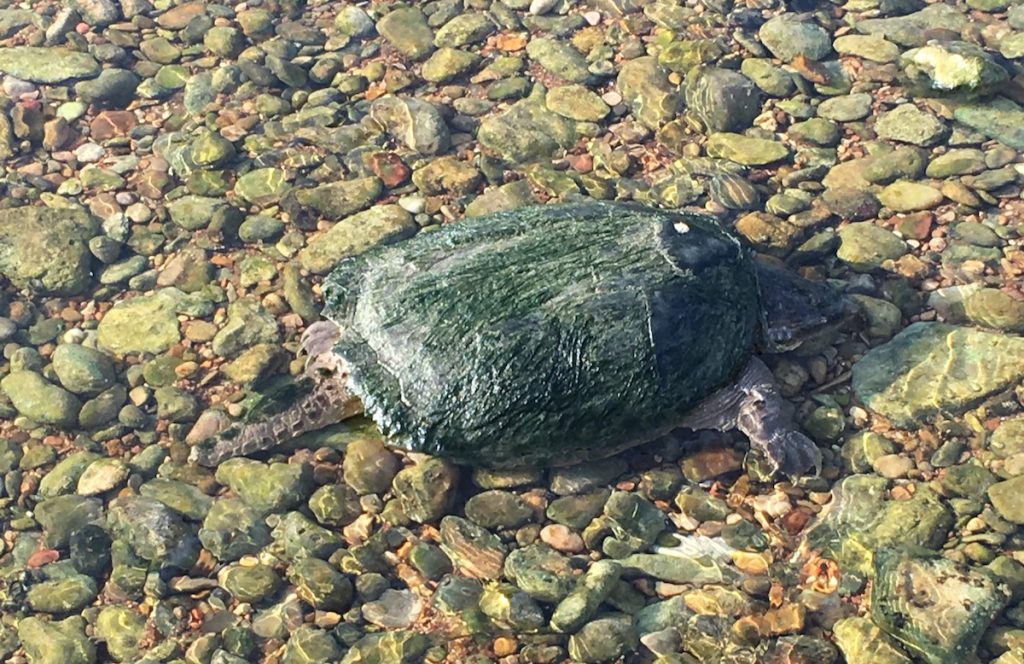
I have known Chris Brown for many years, first through reading his essays in the pages of The New York Review of Science Fiction and other publications, and then in person at Readercon and in a few larger cities. We share an interest in the ragged edges of the planet and in science fiction, and we’ve walked together to one or two of the green worlds you can find just a few steps from the usual paths. His novel Tropic of Kansas was an Endless Bookshelf Book of the Year, “dark, nimble, hilarious, deeply alarming, truly American”, and he was a good person to talk to when I was writing A Conversation larger than the Universe. His Field Notes newsletters are always interesting and fun. Disqualified by such ties of friendship from writing a review of A Natural History of Empty Lots, a book that grew from his years of walking and thinking around in his neighborhood, I asked him the only question that needs asking, and his answer in this singular interview (from A Natural History) is elegant and definitive.
Henry Wessells : Have you ever seen a chupacabra ?
Christopher Brown : Almost a decade after I went on the Bigfoot watch, I had a close encounter with a chupacabra. It was May 2015, on the Sunday night before Memorial Day. We were in Marfa, Texas, where we had taken our visiting friends, Henry Wessells and Mary Jo Duffy, native Philadelphians who live in New Jersey and work in New York. After dinner on our last night, we headed east on Highway 90 to check out the Marfa Lights. It was around 9 p.m. The radio was tuned to the local public radio station, which was playing its “Space Music” show-ambient instrumentals that suited the mood. About two-thirds into the nine-mile drive, a ghostly creature crossed our path, walking right across the road, rather slowly.
Slow enough that we got a long look as it passed through the beams of our headlights. Four-legged, definitely not a deer, a figure of ethereal white. Bigger than a dog, different than a coyote — even though that’s probably what it was. They say most chupacabra sightings are really just coyotes with mange. We all saw it, were similarly baffled, and agreed that it was both something that had a rational explanation that the brevity and circumstances of our sighting would not let us figure out, and that we also had just experienced an encounter that had an authentically paranormal frisson. It was definitely a chupacabra, we understood, as we also understood that a chupacabra is simply a creature you encounter that does not follow the taxonomic indicators of its species, looking so strange, in the moment you see it, as to provide you an experience of the alien and a welcome excuse to make up your own legend.

— — —
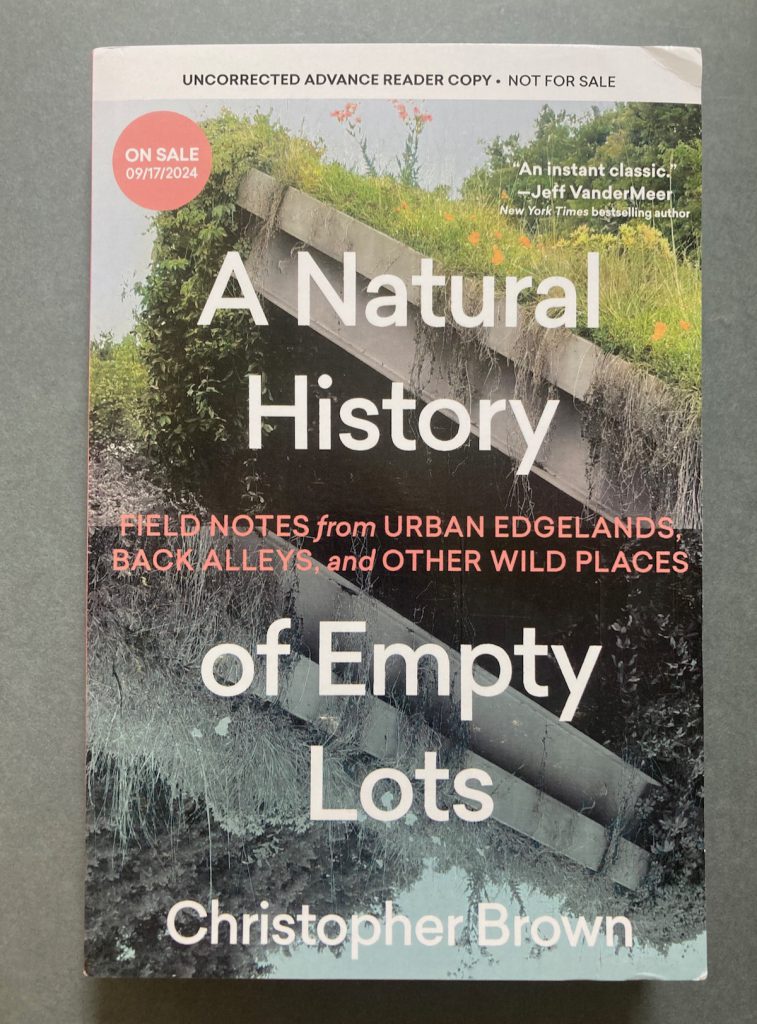
— Christopher Brown. A Natural History of Empty Lots. Field Notes from Urban Edgelands, Back Alleys, and Other Wild Places, forthcoming 17 September 2024 from Timber Press.
Copyright © 2024 by Christopher Brown. Reprinted by permission.
— — —
There are two Elflands for me, the one that I can walk to, and the other one.

I prefer the Elfland that I can walk to. To paraphrase Wittgenstein and turn him upside down, Elfland is a labyrinth of paths. You approach from one side and no longer know your way about; you approach the same place from another side and you know your way about.
One follows a path that escaped notice when walking in the other direction. One, two, three steps, into the forest, up the hill, across a creek, or simply from sunlight to shade, and the border has been crossed. One breathes more easily, even if climbing a steep hill, and the main concerns are to look and listen. For others, I am sure the sense of smell is involved, but I have to rely on memory and other cues. I do remember, once, deep in the forest of Big Sur, the rich moist fragrance of the sequoias and all the leafwrack washing over me. The green of the moss, the play of leaf and shadow. One is there, for a few minutes, a sense of expectation but there is no goal, alertness the only aim.
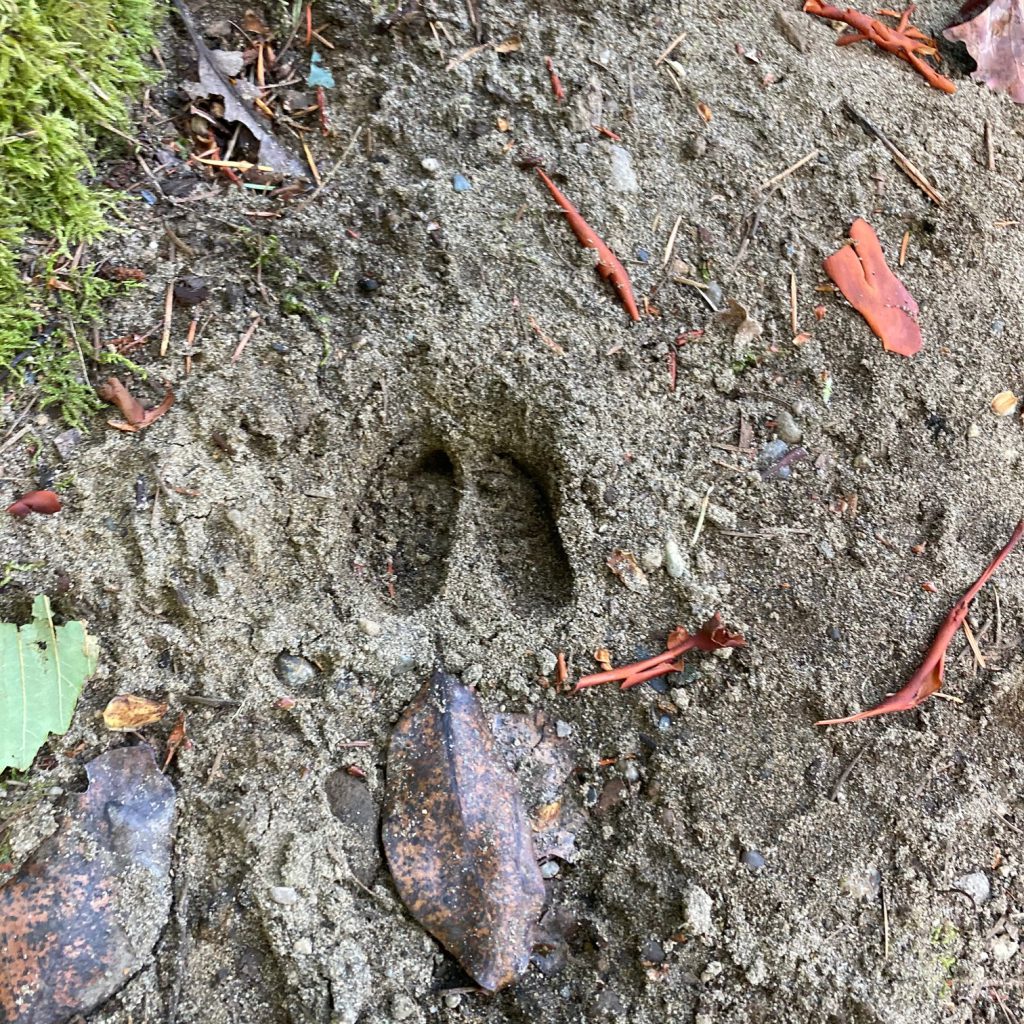
There are even maintained trails in Elfland, perhaps not so new, but steps and other buffers to erosion are sometimes seen along the way. The track of a buck in the center of the path, a rain dappled pad of a coyote in sand, and further up, fresher scat, also in the center of the path.
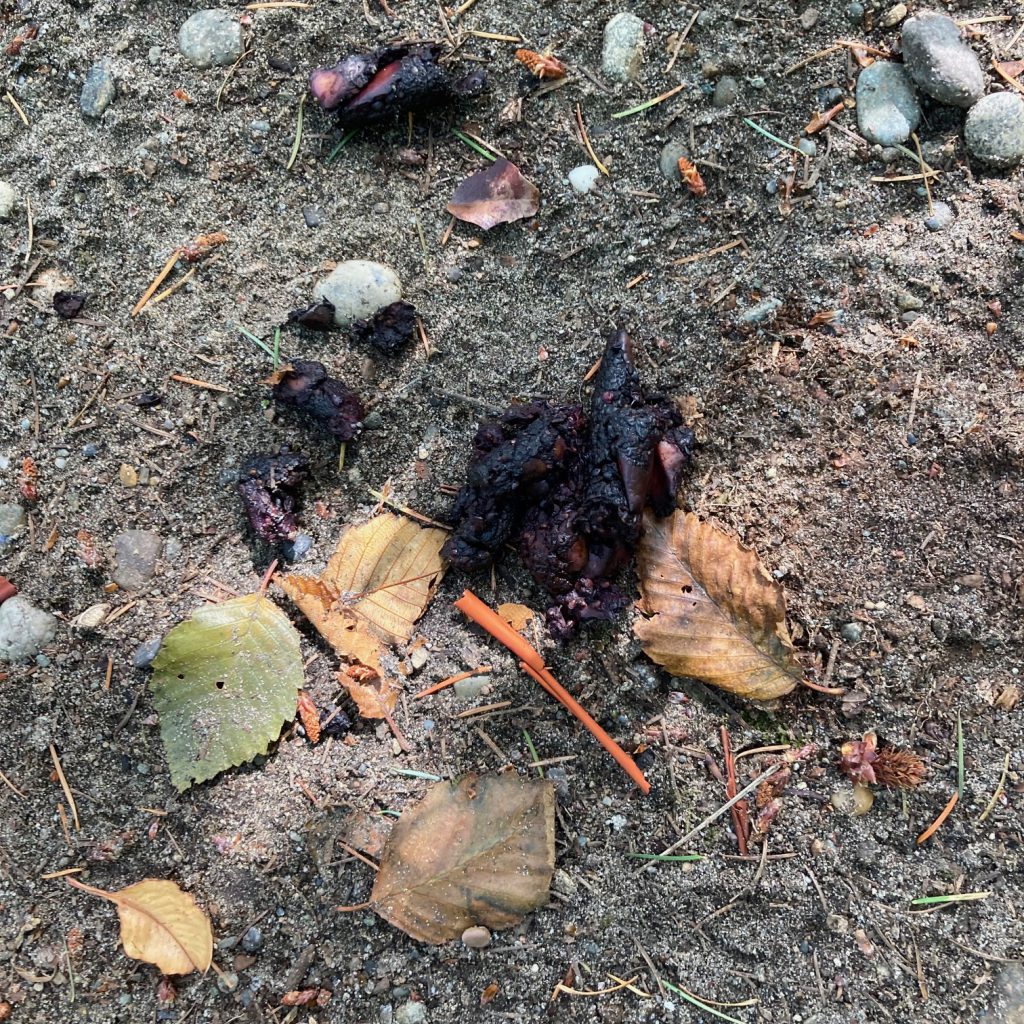
To walk and climb is enough. If the hill is steep, the switchbacks are frequent. A moment’s pause along the way, and that peculiar striated nut-like brown shape is in fact a compact slug. One moves on, up and up, turn and turn again.
This morning’s walk to Elfland was a sudden glimpse of a path between trees on the return leg of an amble at low tide. I walked and climbed for fifteen minutes, up a trail to a sudden and well-tended wooden staircase and that most American sign, Private Property No Trespassing.
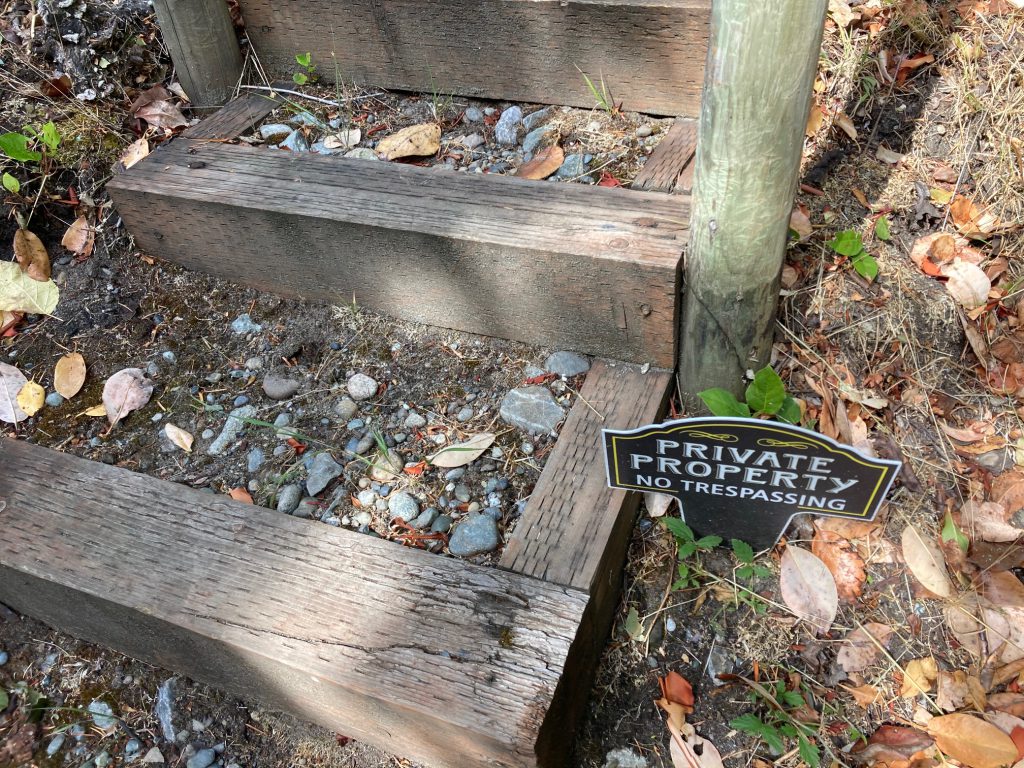
It does kinda change the moment. When I was a child, we were taught to sing Woody Guthrie’s “This Land is Your Land”, but not even at the Quaker woodland camp were we taught the verse about the relief office or this one:
As I went walking I saw a sign there
And on the sign it said “No Trespassing”
But on the other side it didn’t say nothing,
That side was made for you and me.
This land is your land, this land is my land,
This morning, constrained by time and tide, I did not walk up the staircase out of Elfland and into a different adventure (I can usually talk my way into and out of all sorts of places). So I turned back, and walked down through Elfland on a beautiful forest hillside, and returned to the fields we know.
There, at the other fork in the path, I turned and climbed up a broader path to trespass into a large levelled clearing in the high woods, an oval 150 paces in length overlooking the sound, a building site that never happened, perhaps, but now an informal dump or something. The other end of the American dream.

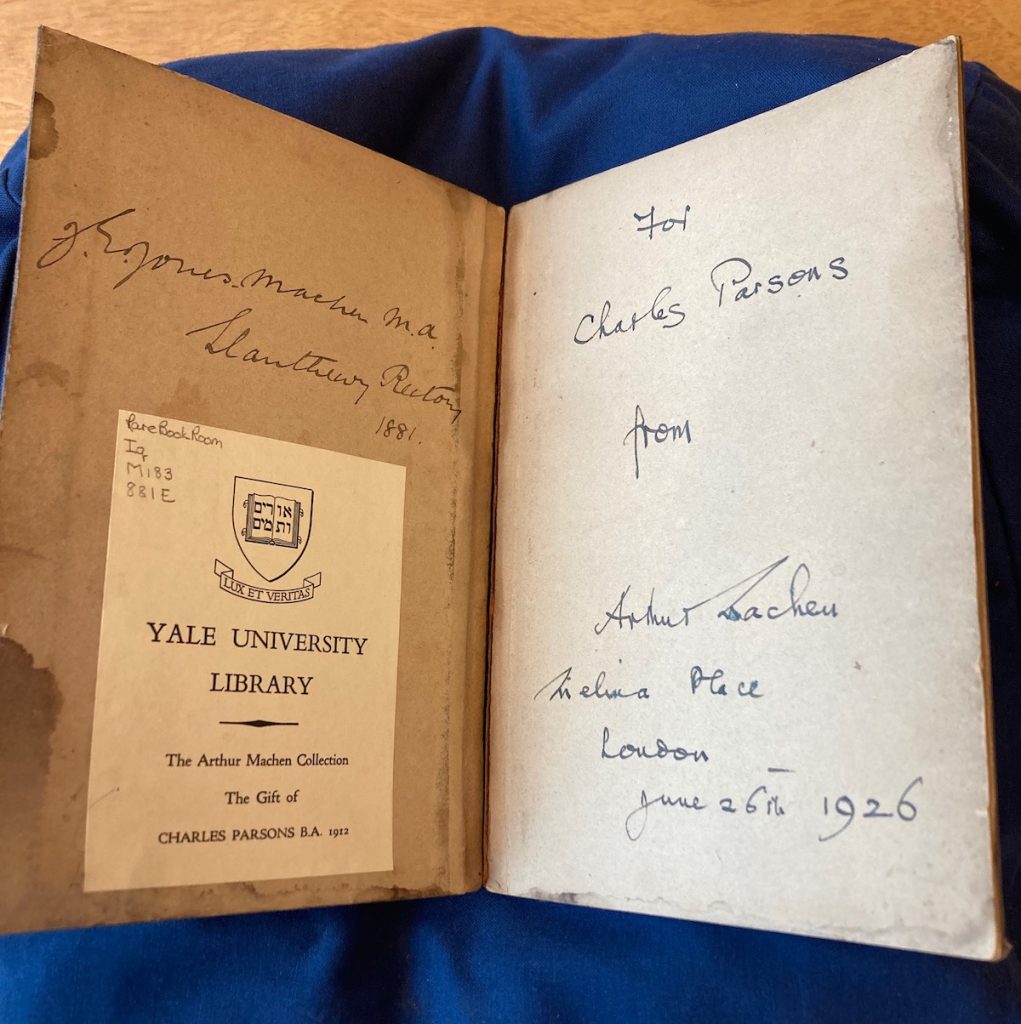
Arthur Machen’s first book, Eleusinia, by a former member of H. C. S., is a sequence of poems celebrating pre-Christian mysteries in the Athens of the young author’s imagination. The pamphlet was printed in Hereford in 1881, and is known from one copy preserved at the Beinecke Library, Yale University. The copy is from the collection of Charles Parsons (Yale class of 1912), who was one of the lenders to the Harry Marks exhibition in 1923. Eleusinia was not, however, exhibited in 1923, for at the time it was still in the author’s possession. But by 1926 his circumstances had changed, and when it happened that one of the American collectors with whom Machen had been corresponding was visiting London, Machen agreed to receive him and to sell his copy of Eleusinia. The picture above shows the pastedown with the Charles Parsons ’12 gift bookplate, and above it is the signature of Arthur Machen’s father John Edward Jones Machen, M.A., Llanthewy Rectory, 1881. Machen’s father paid for the printing of the book, and in his copy he pasted a clipping, a tactful, encouraging press notice, identified as by “Lewis Sergeant Esqre in Hereford Times”. Lewis Sergeant (1841-1902) was a journalist and author and a close friend of the Machen family ; Machen stayed in his house in Turnham Green when he first came up to London. On the flyleaf opposite is the author the inscription at the time of the sale, “For Charles Parsons from Arthur Machen, Melina Place, London, June 26th 1926”. Parsons saved his correspondence with Machen, and the receipt (shown below) is preserved in the files at Beinecke (Gen MSS 256, Box 1 folder 3).
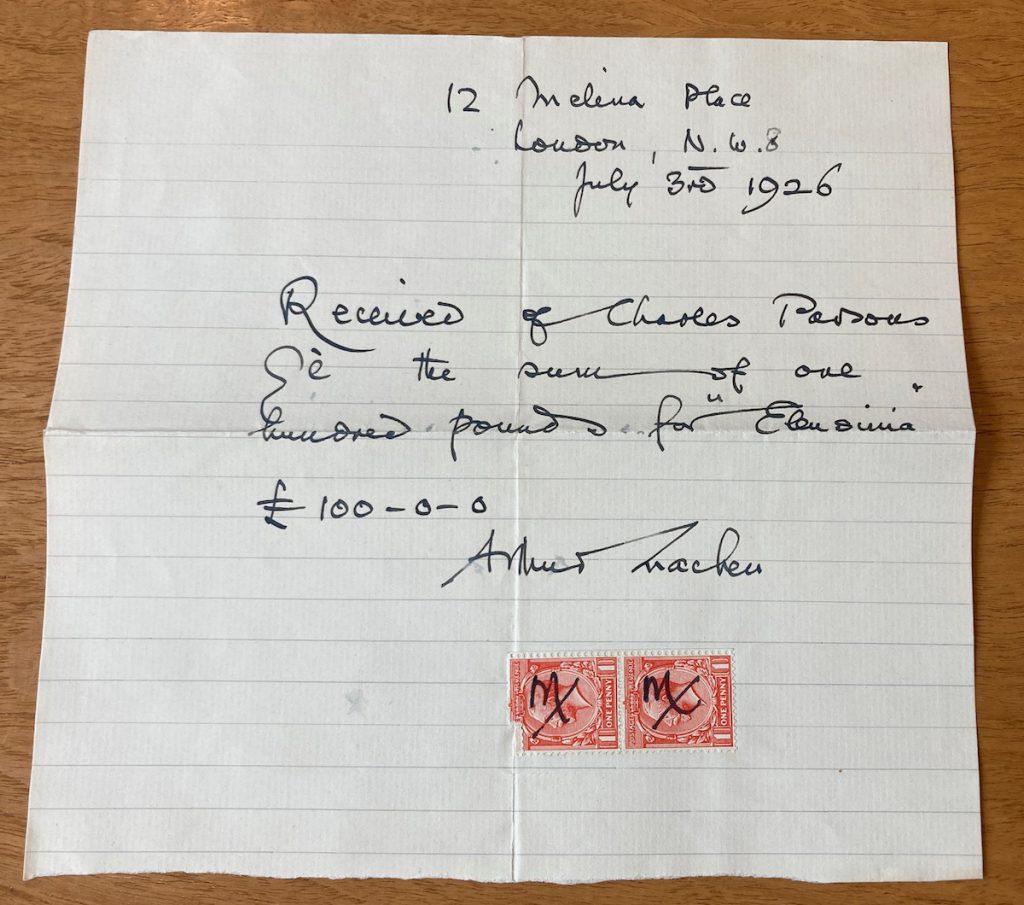
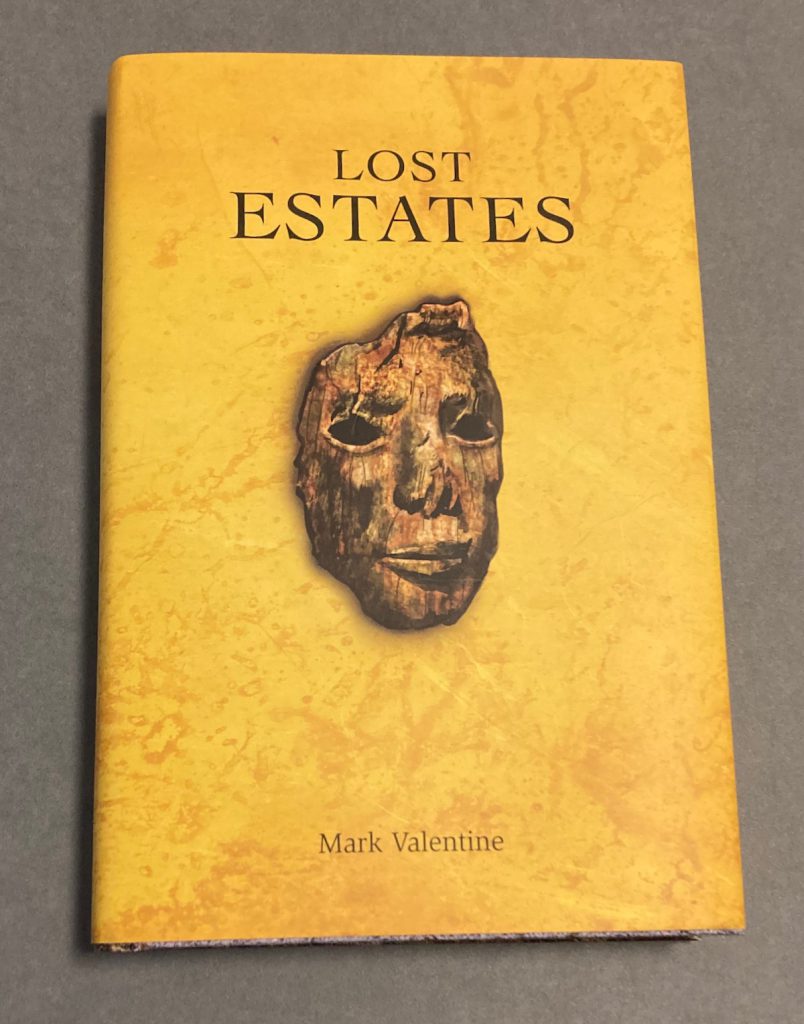
— Mark Valentine. Lost Estates. Swan River Press, 2024. [From the author].
Collection of a dozen stories, four unpublished, including the excellent title story
— — —
— John O’Donoghue. The Servants and other strange stories. Tartarus Press, [2024]. Edition of 300.
Collection of nine stories and novellas ; including “The Irish Short Story That Never Ends” : though its title reveals how it must end, this is pitch perfect and evocative and finely executed. Michael Swanwick —himself a master of concise, brilliant short stories — notes, “John O’Donoghue knocks it out of the park . . . I’m Irish, so this goes to the heart of a lifetime of reading for me.”
— — —
— John Buchan. The Three Hostages. Houghton Mifflin, 1924.
Re-read this for the first time in more than forty years, for an essay appearing in Wormwoodiana on the centenary (1 August).
— — —
— Anthony Powell. A Question of Upbringing (1951) ; A Buyer’s Market (1952) ; The Acceptance World (1955) ; At Lady Molly’s (1957) ; Casanova’s Chinese Restaurant (1960) ; The Kindly Ones (1962) ; The Valley of Bones (1964) ; The Soldier’s Art (1966) ; The Military Philosophers (1968) ; Books Do Furnish a Room (1971) ; Temporary Kings (1973) ; Hearing Secret Harmonies (1975).
I have been working at the ‘Dance to the Music of Time’ over the past several months, mostly reading the dozen novels out of sequence, which seems a reasonable enough approach, since the narratives flit and somersault across time and the parade of characters is intermittent and recurring by design. The humor is dry and Powell’s principal strategy, “the discipline of infinite obliquity”, will not be to every reader’s taste, but things do happen, often as sudden surprises punctuating a circumspect, even evasive, chronicle. And of course the sentences and paragraphs sometimes turn in midstream to undermine or contradict the initial idea or perspective expressed. Or how about this : “She had the gift of making silence as vindictive as speech.”
Powell’s cycle was described by several of his contemporaries as an English Proust but that now seems to me to be a reductive statement : there is attention to art, music, and aesthetics, and a complex, intertwined cast of artists, hacks, critics, businessmen, elegant and not-so-elegant family members, and even Venice makes an appearance, but Nicholas Jenkins is, by temperament, energy, and accomplishment, about as far from the “Marcel” narrator as can be and so is the overall tone. I like The Military Philosophers (which does have a direct nod to Proust) and At Lady Molly’s most of all, but this is maybe saying “poached” or “over easy”. Certainly the outcomes of Hearing Secret Harmonies are a long way from the schoolboy memories of 1921 in the first volume.
— — —
— (MELVILLE, HERMAN). Melville’s Billy Budd at 100. A Centennial Exhibition at the Grolier Club and Oberlin College Libraries. Introduction and Descriptions by William Palmer Johnston. Frontispiece portrait of Melville by Barry Moser, color plates. The Grolier Club, 2024. Edition of 375 copies printed by Bradley Hutchinson in Austin, Texas. [Gift of the author].
Advance copy of this concise, elegant catalogue for the show (12 September to 9 November in NYC) : 49 entries, 1843-2024, including some legendary Melville rarities and new work by an American master. A symposium on Billy Budd will be held at the Club on 9 October in connection with the exhibition.
The catalogue is distributed by the University of Chicago Press.
— (MELVILLE, HERMAN) Bound to Vary. A Guild of Book Workers exhibition of unique fine bindings on the Married Mettle Press limited edition of Billy Budd, Sailor. New York: Guild of Book Workers, 1988.
A superb copy of this edition of Billy Budd (one of the unique bindings) will be on view at the Grolier.
/ file under : chronicle of an obsession
— — —

— Michael Swanwick. The War with the Zylv. Cover illustration by Ariel Cinii. Dragonstairs Press, 2024. Edition of 100.
— — —

— Anuj Bahri and Aanchal Malhotra. Bahrisons. Chronicle of a Bookshop. [New Delhi :] Tara India Research Press, [2024].
Seventieth anniversary memoir and keepsake from this New Delhi bookshop established by an enterprising young refugee couple displaced during Partition : ‘we were not just in the business of selling books, but rather, building relationships’.
— — —
— Bob Rosenthal. Fifth Avenue Overhead. Edge Books, [May, 2024].
“Stories of Poetic Survival” by the author of Cleaning Up New York. This is a fun book!
— Arthur Machen. A Reader of Curious Books. [Edited by Christopher Tompkins]. Darkly Bright Press, [2024].
Expanded second edition (originally issued in 2020) of this annotated compendium of early work by Machen, reviews and literary miscellanies from the pages of Walford’s Antiquarian in 1887 [cf. Goldstone & Sweetser, pp. 141-3], some using the pseudonym Leolinus, and often containing in miniature some of the author’s later interests and motifs.
— John Masefield. Sard Harker. Heinemann, 1924.
For a forthcoming essay.
— Matthew Needle, Bookscout. An Appreciation by His Friends. Cambridge, Mass.: Charles Wood, Bookseller, 2012.
Reminiscences by Gregory Gibson, Adrian Harrington, Robert Rubin, Marcus McCorison, Roger Stoddard, Charles Wood, Stephen Weissman.
— — —

— Charlotte Perkins Gilman. The Yellow Wall-Paper. Afterword by Alice Walker. Illustrations by Chris Daunt. Suntup Editions, 2024. Edition of 376 copies, signed by Walker and Daunt.
— — —

— Francis Spufford. Cahokia Jazz [2023]. Scribners, [2024].
A Prohibition novel, a jazz novel, and an excellent novel of an alternate America, a narrative organically rooted in language and anthropology. I really liked this one.